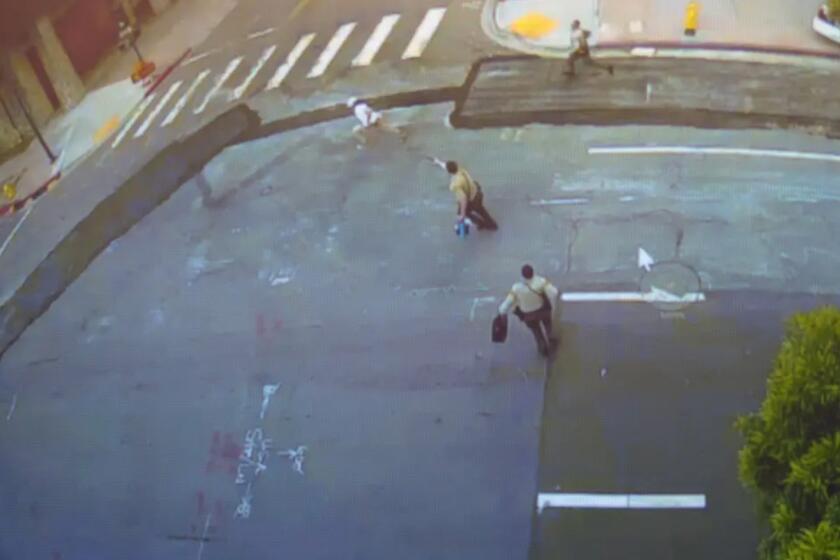Police Officers Face New Hazard: Assault by Air Bag
One patrol officer had his nose broken by a laptop computer. Another was smacked with the butt of his shotgun and knocked unconscious. A third got poked in the eye by wires from his radar unit and lost part of his vision.
The culprit in each case was not a raging assailant, but the passenger-side air bag in the cops’ squad cars. When an air bag deploys in a crash, it can turn equipment unwittingly mounted in its path into a high-energy missile, safety experts say.
Laptop computers, cell phones, radar units and other technological accessories of the modern police cruiser have become hazards for officers in crashes, according to federal and independent investigators. Police officers may soon join children, small women and the elderly on the list of those at risk of airbag injuries.
“It’s an issue that needs to be brought to the attention of the law enforcement community,” said Rae Tyson, a spokesman for the National Highway Traffic Safety Administration, which is issuing a safety alert this week. “As time goes on, they are adding more and more equipment to these patrol cars.
“We want to make sure they don’t mistakenly install something in the direct path of an air bag.”
The precise number of officers injured in such accidents is unknown, but Dave Long, an air-bag safety consultant for North Memorial Medical Center near Minneapolis, said he has collected information on at least 20 cases. NHTSA has investigated one crash, involving a Louisiana police officer hurt by a flying laptop computer when his patrol car hit the back of a transit bus last summer, Tyson said.
“Most cops are not willing to give out information about this,” said Long. “It’s not something you’re really proud of. They don’t want to say they busted a $2,000 computer, got an officer hurt and stuff was whooshing through the air.”
The California Highway Patrol, which has a fleet of about 2,500 cruisers, became aware of the problem several years ago through its own testing, said Capt. B.J. Hall, commander of the motor transport section. The tests involved setting off the passenger-side air bag and recording the results.
“We did a video, and the first time we tried it, we found we would have knocked some equipment into the driver,” said Hall. “We make sure we don’t mount anything in the deployment zone.”
Many smaller departments do not have budgets for testing or for complicated installation of equipment. Some have used bungee cords to strap gear down on top of the dash.
“I’ve seen how some people got their stuff mounted, and it scares me,” said Hall, who added that he was not aware of any injuries to CHP officers.
Air bag deaths have dropped from a high of 53 in 1997 to five confirmed fatalities last year. Traffic safety officers have played an important role in this trend by enforcing seat-belt laws and encouraging parents to put their children in the back seat. But when it comes to their own safety, the cops seemingly have a blind spot.
Long, who works with police, fire and rescue units, said he informally surveyed official vehicles at a highway safety conference last summer. About one-third of more than 300 vehicles in the parking lot had gear installed in front of the passenger-side air bag.
Police and fire departments have two options to avoid problems: They can make sure that any accessories are installed out of the way of the air bag by following instructions issued by manufacturers, or they can have a switch installed to turn off the passenger-side air bag. Neither solution is considered ideal.
The center console of most cruisers is safe from an air bag deployment, but it simply does not offer a lot of space for mounting equipment. “By the time you add six electronic items, it gets very narrow,” Long said.
Hall said the CHP mounts its laptop computers so they are under the path of a deploying air bag. But some officers don’t find that very convenient. “They like to have it close, so they can type and keep an eye on things at the same time,” said Long.
The other solution, a switch to turn off the air bag, requires an application for permission from the federal government. It can cost $200 to $300 per vehicle to install the switch.
“Many departments do not know where to go get the air bag deactivated,” said Long. “Many dealerships do not want to do this type of work, because they don’t want the liability.”
In the future, police cars may come with most of their equipment built in. After all, manufacturers are currently installing video systems and navigational computers on their high-end models for consumers.
For now, the proliferation of added-on electronic gear is likely to continue, particularly with increased anti-terrorism funding to better equip first responders.
“If you don’t mount the equipment in exactly the right place,” said Long, “you can get a computer hitting a cop’s face at 200 miles per hour.”
More to Read
Start your day right
Sign up for Essential California for news, features and recommendations from the L.A. Times and beyond in your inbox six days a week.
You may occasionally receive promotional content from the Los Angeles Times.






